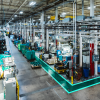
Heading
Smart Manufacturing Blog
Description
Welcome to your source for all things smart manufacturing. Whether you’re looking for expert insights, hard data, or actionable tips for your plant floor, we’ve got you covered every week of the year.

Now Available!
Get your copy of the 7th Annual State of Smart Manufacturing and hear from 300+ manufacturers in this new survey report!
Modern Manufacturing
Plex Manufacturing Blog
Production Monitoring KPIs – Greater Visibility Means Higher Production
The U.S. military uses advanced technology to extend the capabilities of its systems. From satellite images to radar and "eye in the sky" electronic surveillance planes, the goal is to extend visibility past the horizon so troops can see whatever is coming their way. They can see a macro version of a field to view the entire picture or zoom in to look at individual buildings, vehicles, or people…
Read MoreLeverage Your Data to Unlock Hidden Capacity and Supercharge Processes
Capital equipment is one of the most significant variables in calculating a manufacturing company’s capacity. The higher the capacity, the more business a company can take on. Optimizing that capacity means a more substantial ROI, which leads to higher profits and less new equipment in the future....
Read MoreIndustry 4.0: Go Big or Go Small - Just Go
Traditionally, large manufacturing companies benefited from scale. They could put money, resources, and in-house expertise into implementing massive enterprise-level software like an ERP or MRP. Smaller companies with limited resources, capital, and expertise under their roof had trouble acquiring the benefits of such software. This disadvantage meant they had to utilize manual data collection,…
Read MoreThe Machines Are Not out to Get You: Making AI Work for Your Manufacturing Operation
You can hardly turn on a news or media channel these days without a reference to artificial intelligence (AI) and how it affects everyone. AI, alongside other core technologies from Industry 4.0, are already transforming many industries. For manufacturing, AI is poised to be no less impactful. AI as the driver of manufacturing operations is advancing rapidly, but despite its potential, there are…
Read MoreWhen You Don’t Know What’s Broken: Fighting Frightening Manufacturing Monsters
Bumps, clanks, hisses, and creaks. What’s that noise? In a manufacturing operation, just like a Halloween movie, these sounds are always scary. But sometimes, we don’t hear the sounds until they’ve jumped out at us, eliciting a haunted-house scream and a bit of embarrassment that we didn’t see it coming....
Read MoreNorth American Food Safety and Quality: Your NAFS22 Recap
NAFS22 came packed with insights, ideas, and a shared call to action to achieve food safety and quality like we’ve never seen before. After days of conversations and presentations, the key question that remains is: how do we achieve this, particularly on a national and international scale? Of the many topics discussed over the last several days, these are the ones that stood out most:...
Read MoreYour Answer for Managing Major Manufacturing Disruption
In past decades, business continuity was mainly considered to respond to the dangers of natural disasters like fires, floods, or hurricanes. The dawn of the internet brought a new focus to continuity; it broadened its definition as companies raced to protect data from cyberattacks and breaches that could shut them down and leave them without critical information....
Read MoreThe Shift to Electric Vehicles and Its Impact on Automotive Suppliers
The inevitable shift to electric vehicles is here and its impact on automotive suppliers will be drastic. OEMs are making major commitments to reduce their carbon footprint and eliminate their internal combustion engine (ICE) fleets. General Motors, for example, has made a commitment to be completely carbon neutral in their global products and operations by 2040 and eliminate tailpipe emissions…
Read MoreHow Risk and Complexity Are Linked in Manufacturing
Not all manufacturing is the same. Some finished goods take only a few steps and a little sub-processing before they’re ready for shipment. Others may require precision cuts and tight tolerances that bring them within requirements for more precise monitoring and equipment. And yet others are deeply derivative with multiple sub-processes, subtractive or additive processes, and complex assembly....
Read MoreA Guide to Process Automation
“Automation” means different things to different manufacturers, depending on the equipment, systems, and processes in place. But many companies only automate some of their processes, leaving others disconnected or with manual processes still in place....
Read More









